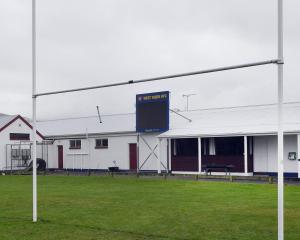Seven years of research on the environmental impact of commercial clam harvesting in Otago Harbour is nearing an end. Shawn McAvinue hits the harbour for a research harvest as the Government gets set to decide if it will lift its regulated closure.
Central Africa might seem a world away when you are standing in the middle of Otago Harbour.
Former Cameroon resident Alain Njoh Njoh has been harvesting littleneck clams from the harbour for Dunedin business Southern Clams for four years.
''This is the way I pay the bills. This is my life now.''
When the Otago Daily Times waded in on his work day, he was part of a crew harvesting five tonnes of clams to order from a bed south of Quarantine Island.
Southern Clams operations manager David Redshaw said a certain technique was needed to push the harvesting dredge strapped to workers' bodies across the bed and it helped if the person pushing it weighed more than 100kg.
Often harvesters had to work in near-freezing waters up to their elbows, while being barked at by a sea lion, Mr Redshaw said.
The crew worked to a deadline and clams had to be in the factory in Bombay St by 10.30am to reach Christchurch by 9pm the same day and be airfreighted the next day to Los Angeles for distribution to six clients across the United States.
Southern Clams had been operating a commercial clam fishery in two areas of the harbour, covering 180ha north and south of Quarantine Island, under a special permit since 2009, Mr Redshaw said.
The Government gave the permit to research the effect of commercially harvesting clams from the harbour and to determine if it was sustainable.
The seven-year permit would expire on January 31 and the last of three independent survey on the effects of harvesting would be complete in mid-January.
Each survey was reviewed by the Ministry for Primary Industries (MPI).
The reviewers had to be satisfied there had been no adverse effects on other species before Southern Clams could proceed to the next phase, Mr Redshaw said.
He was confident the findings would show the environmental impacts were minimal, as had been the case in the earlier surveys.
He hoped Southern Clams would be permitted to harvest clams commercially from the harbour by the middle of 2017.
''So far it is looking positive.''
The ''controlled experiment'' was the first of its kind in New Zealand.
Half the research area was harvested and the other half was ''untouched'' as a control.
The clams, often incorrectly called cockles, were ''prolific'' breeders, so much so, beds could become overcrowded, stunting the clams' growth.
''Just like thinning carrots, harvesting clams allows the rest to grow bigger, faster.''
A challenge of the project was finding a suitable market for the clams harvested for research.
As the harbour clams had never been harvested, they were not of the same appearance or quality as those harvested from Blueskin Bay for the past 30 years.
Consequently, the clams were not of a standard to supply high-end restaurant markets overseas.
''Fortunately, we were able to secure an American supermarket chain which was happy to purchase them as run of catch. The more the old beds are thinned out, the better quality the new recruits become and we have already begun to witness that.''
If the harbour was open to commercial fishing it would ensure ''continuity of supply'' for Southern Clams.
Blueskin Bay was Southern Clams' main harvest area but it was closed for up to 68 days a year because of variable water quality.
The water quality of Otago Harbour was ''vastly superior'' and if the harbour was opened it would enable Southern Clams to provide continuity of supply to markets that demanded it.
''That's why we now need the lifting of the regulatory closure.''
Southern Clams had invested in research and development and was ''poised'' to expand its product line and increase the size of its work force with ''the confidence that what we are doing is totally sustainable''.
Otakou runanga representative Edward Ellison said commercial clam harvesting in the harbour had been a ''difficult issue'' for Otakou runanga members.
Clams were ''taonga'' - a treasured item.
''It has been an issue we as a runanga have had to face,'' he said.
The runanga would meet MPI staff to discuss the end of the research permit and the future direction of the fishery.
An MPI spokesman said results from earlier research stages confirmed the environmental impacts of commercial clam harvesting were ''minor and manageable''.
Results from the final stage would be completed and released early this year.
When the special permit expired, commercial fishing of clams in the harbour would cease to be authorised because of a generic fisheries regulation prohibiting the commercial harvest of some shellfish from the harbour, the spokesman said.
The original reasons for the regulation were related to food safety (water quality) issues, which were no longer relevant, he said.
The ministry would review whether the regulation should be amended to allow the commercial harvest of clams to continue in the two parts of the harbour.
The review would include public consultation, the spokesman said.
Advertisement



















